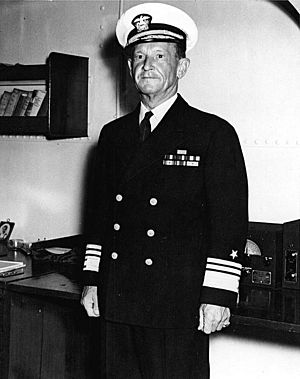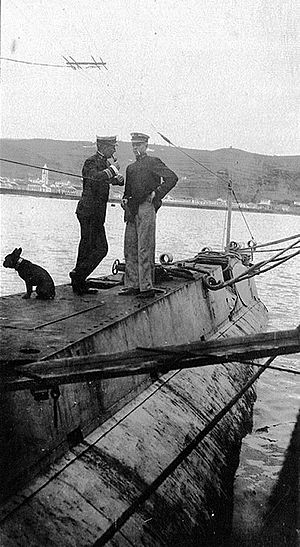Frank Jack Fletcher facts for kids
Quick facts for kids
Frank Jack Fletcher
|
|
|---|---|

Vice Admiral Frank Jack Fletcher, USN Photographed aboard USS Saratoga, September 17, 1942. Official U.S. Navy photograph.
|
|
| Nickname(s) | Black Jack |
| Born | April 29, 1885 Marshalltown, Iowa, US |
| Died | April 25, 1973 (aged 87) Bethesda, Maryland, US |
| Place of burial | |
| Allegiance | |
| Service/ |
|
| Years of service | 1906–1947 |
| Rank | |
| Commands held |
|
| Battles/wars | Mexican Revolution
|
| Awards |
|
| Relations | Admiral Frank Friday Fletcher (uncle) |
Frank Jack Fletcher (born April 29, 1885 – died April 25, 1973) was an important admiral in the United States Navy. He served during World War II. Admiral Fletcher led five different groups of ships, called task forces, during the war. He was the main commander in charge of the battles of the Coral Sea and Midway. These battles were very important. In them, five Japanese fleet carriers were sunk.
In 1914, when he was a Lieutenant, Fletcher received the Medal of Honor. This was for his brave actions during the battle at Veracruz, Mexico. His uncle, Admiral Frank Friday Fletcher, also won the Medal of Honor for his actions at Veracruz.
Contents
Frank Jack Fletcher was born in Marshalltown, Iowa. This was on April 29, 1885. He joined the U.S. Naval Academy in 1902. He finished his studies in 1906. After two years at sea, he became an Ensign in 1908.
After graduating, he served on battleships like Rhode Island and Ohio. These ships were in the Atlantic Ocean. Later, he joined the destroyer Chauncey in Asia. In 1910, he took command of the destroyer Dale. He returned to command Chauncey in 1912.
In April 1914, he was on the battleship Florida. This ship was the main ship for his uncle, Frank Friday Fletcher. During the occupation of Veracruz, Mexico, he helped rescue people. For this brave act, he earned the Medal of Honor. After this, he worked for the Commander in Chief of the U.S. Atlantic Fleet. Then he returned to the Naval Academy.

World War I and Between Wars
During World War I, Fletcher was a gunnery officer on Kearsarge. In 1917, he took command of Margaret. He later commanded the destroyer Benham. He received the Navy Cross for his important and difficult work.
After the war, he helped prepare new destroyers for service. He commanded Gridley for a short time. Then he worked in Washington, D.C., helping with Navy personnel.
In the years between the World Wars, Fletcher served in Asia. He commanded several ships, including Whipple and Sacramento. He also led the submarine base at Cavite. He later became the executive officer of the battleship Colorado. He studied at the Naval War College and the United States Army War College. These studies prepared him for important leadership roles.
From 1933 to 1936, he was an assistant to the Secretary of the Navy. In 1936, he commanded the battleship USS New Mexico. By November 1939, Fletcher was promoted to Rear Admiral. He commanded Cruiser Division Six when the Japanese attacked Pearl Harbor in December 1941.
World War II Battles
Pearl Harbor and Wake Island
When the Japanese attacked Pearl Harbor on December 7, 1941, Admiral Fletcher was at sea. He was commanding Cruiser Division Six. After the attack, Admiral Kimmel, the commander of the Pacific Fleet, trusted Fletcher. He put Fletcher in charge of Task Force 14. This group was sent to help Wake Island.
Wake Island was under attack by the Japanese. Fletcher's task force included the aircraft carrier Saratoga. However, the relief mission faced delays. The new commander of the Pacific Fleet, Admiral William Pye, ordered Task Force 14 to return to Pearl Harbor. This was because of new Japanese attacks and concerns about Japanese ships in the area. So, the mission to help Wake Island was called off.
Learning Carrier Operations
On January 1, 1942, Fletcher took command of Task Force 17. This group was built around the carrier Yorktown. Even though he was a surface ship admiral, he was chosen to lead a carrier group. He learned how to run air operations while on the job. He escorted troops to the South Pacific. He also worked with experienced admirals like William Halsey and Aubrey Fitch.
Battle of the Coral Sea
In May 1942, Fletcher led the task forces in the Battle of the Coral Sea. This was a very important battle. It was the first time that aircraft carriers fought each other without the ships seeing each other. Fletcher's Task Force 17, with Yorktown, joined with Rear Admiral Aubrey Fitch's Task Force 11, with Lexington.
They attacked Japanese landing beaches at Tulagi. Then they looked for the main Japanese fleet. On May 7, Fletcher's planes found and sank the Japanese aircraft carrier Japanese aircraft carrier Japanese aircraft carrier Shōhō. This ship was protecting enemy troop ships. That same day, Japanese planes attacked the American tanker Neosho, thinking it was a carrier. They badly damaged it and sank its escort, Sims.
On May 8, both sides launched their planes. The Japanese carrier Shōkaku was hit. The American carrier Lexington was hit by torpedoes and had to be abandoned later that day. Yorktown was also hit but survived. The Japanese invasion fleet, now without air cover, had to turn back. This stopped the invasion of Port Moresby.
Fletcher achieved his goal. He stopped the Japanese invasion. The U.S. lost one carrier, a tanker, and a destroyer. But the Japanese lost one carrier and had another badly damaged. These damaged carriers could not join the next big battle at Midway. This was the first time the Japanese Navy had been stopped in World War II.
Battle of Midway
In June 1942, Fletcher was the main commander at the Battle of Midway. He had Task Force 17 with the repaired Yorktown. He also had Task Force 16, with Enterprise and Hornet. Admiral Raymond A. Spruance commanded Task Force 16 because Admiral Halsey was sick.
The U.S. Navy knew about the Japanese attack plans because they had broken Japanese codes. When Japanese planes attacked Midway Island, the three U.S. carriers were waiting. They attacked and sank three Japanese carriers: Akagi, Kaga, and Sōryū.
Japanese attacks badly damaged Yorktown. Fletcher's scout planes then found the fourth enemy carrier, Hiryū. Planes from Enterprise and Yorktown then sank it. A Japanese submarine later found the damaged Yorktown and sank it, along with a destroyer, Hammann.
At Midway, four of Japan's seven large carriers were sunk. This battle did not end the war, but it made the fight between the U.S. and Japanese navies more even. After the battle, Fletcher was promoted to Vice Admiral. He continued to command a carrier group, moving his flag to Saratoga.
Guadalcanal and Eastern Solomons
In August 1942, Vice Admiral Fletcher led Task Force 61. This was during the invasion of Tulagi and Guadalcanal by the 1st Marine Division. His carriers provided air support for the Marines. Fletcher decided to pull his carriers back from the area. This was because his planes had suffered losses and his ships needed to refuel. He believed it was too risky to keep the valuable carriers in danger from land-based bombers.
The battle of Savo Island happened on August 9, 1942. Allied warships protecting the transports were surprised by Japanese ships. Three U.S. heavy cruisers and one Australian cruiser were sunk. Fletcher's carriers were too far away to help. The Navy then had to withdraw the transport ships. This left the Marines on Guadalcanal without all their supplies.
Fletcher fought another major battle, the battle of the Eastern Solomons. He started the fight, and his forces sank another Japanese carrier, Ryūjō. The battle was mostly an air fight. The U.S. lost 20 planes, while the Japanese lost 70. The Japanese withdrew without landing more troops on Guadalcanal.
On August 31, 1942, Fletcher's flagship, Saratoga, was hit by a Japanese submarine's torpedo. Fletcher himself got a cut on his head and received the Purple Heart. He was then given a break from combat.
Command in the North Pacific
From November 1942 to 1945, Fletcher commanded naval forces in the North Pacific. He was based on the Alaskan island of Adak. He was in charge of the Thirteenth Naval District and the Northwestern Sea Frontier. Later, he commanded the Alaskan Sea Frontier and the North Pacific Force. In 1945, his forces made the first attacks through the Kurile Islands into the Sea of Okhotsk. They also bombarded Paramushir.
After the War and Final Years
In September 1945, after World War II ended, Fletcher led the North Pacific Force to Ōminato, Japan. This was for the naval occupation of Northern Japan. He stayed there until he was ordered back to the United States. In December 1945, he joined the Navy's General Board. He became its Chairman in May 1946. He retired from active duty on May 1, 1947, as a full admiral. He then lived at his home in Maryland.
Many of Fletcher's personal papers were lost during the war. He chose not to help historians reconstruct them. Because of this, some historians did not give him enough credit for his actions. However, some people believe he deserves more recognition for his forces sinking six Japanese carriers.
Frank Jack Fletcher passed away on April 25, 1973. He was almost 88 years old. He is buried in Arlington National Cemetery. His wife, Martha Richards Fletcher, passed away a year later and is buried next to him.
Awards
| Medal of Honor | |||
| Navy Cross | Navy Distinguished Service Medal | Army Distinguished Service Medal | |
| Purple Heart | Mexican Service Medal | World War I Victory Medal with "DESTROYER" clasp |
|
| Yangtze Service Medal | American Defense Service Medal | Asiatic-Pacific Campaign Medal with five battle stars |
|
| American Campaign Medal | World War II Victory Medal | Navy Occupation Service Medal with "ASIA" clasp |
|
- Companion, Order of the Bath (Dominion of Canada) (1945)
- Mindanao and Sulu Campaign Medal (Philippine Territory) (1924)
- Order of the Dragon of Annam (French Indochina) (1932)
Legacy
The Spruance-class destroyer Fletcher (DD-992) was named after Frank Jack Fletcher. It was the second ship to carry this name. The first ship, Fletcher (DD-445), was named for his uncle, Frank Friday Fletcher.
In the 1976 movie Midway, the character of Fletcher was shown as a bit confused. This was based on some Navy veterans' opinions.
See also
 In Spanish: Frank Jack Fletcher para niños
In Spanish: Frank Jack Fletcher para niños

